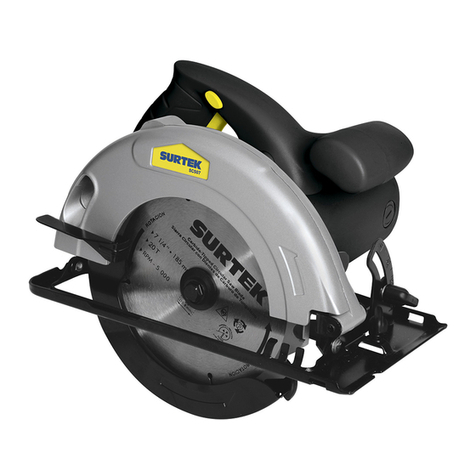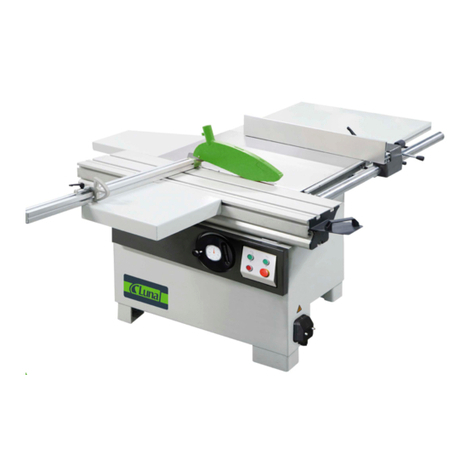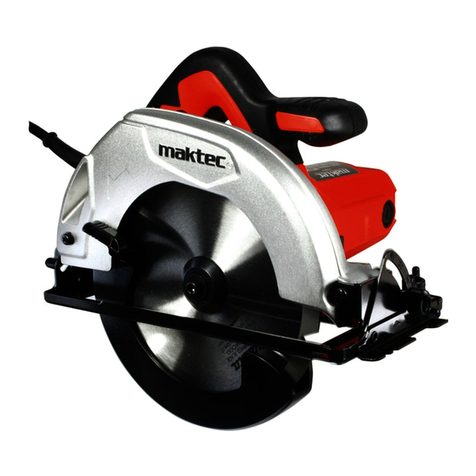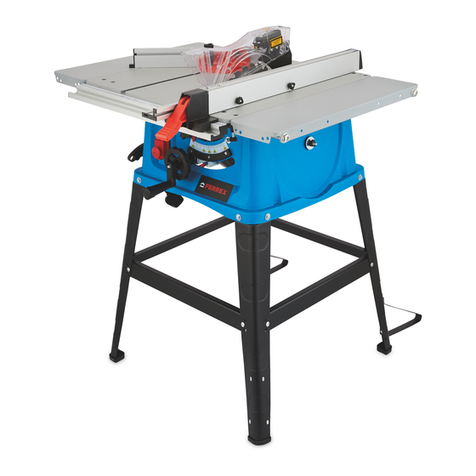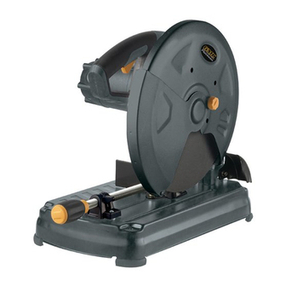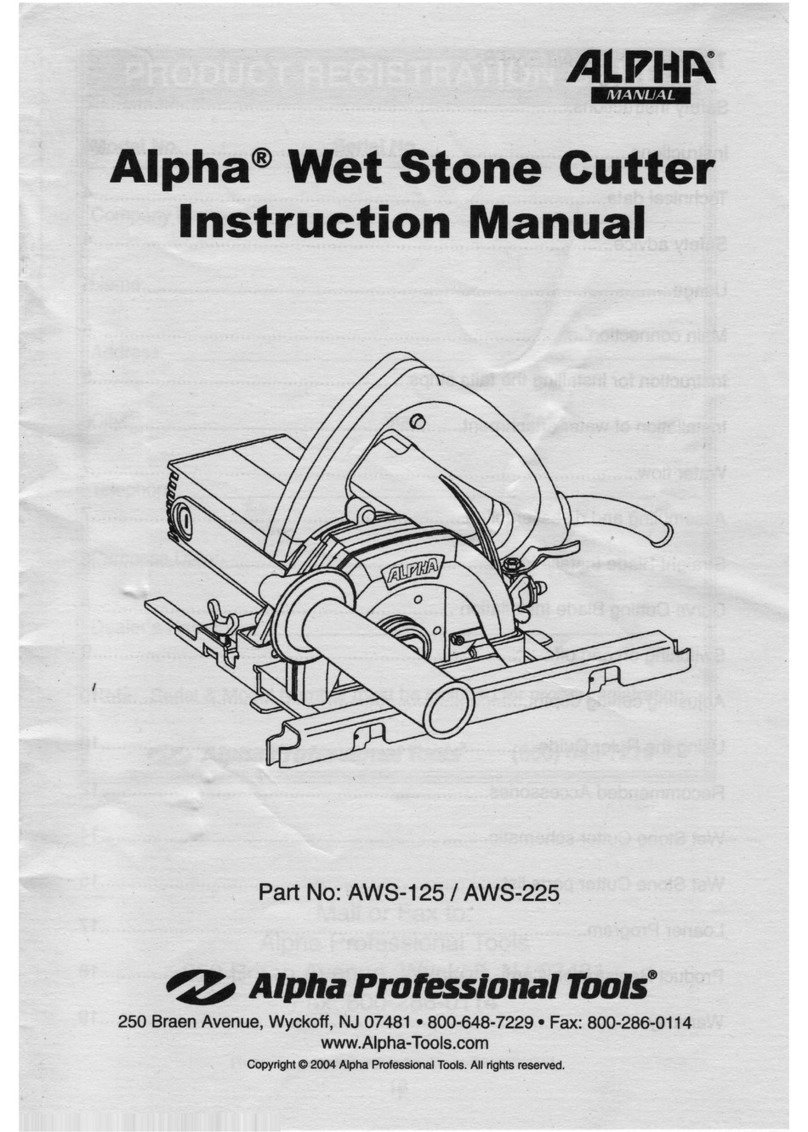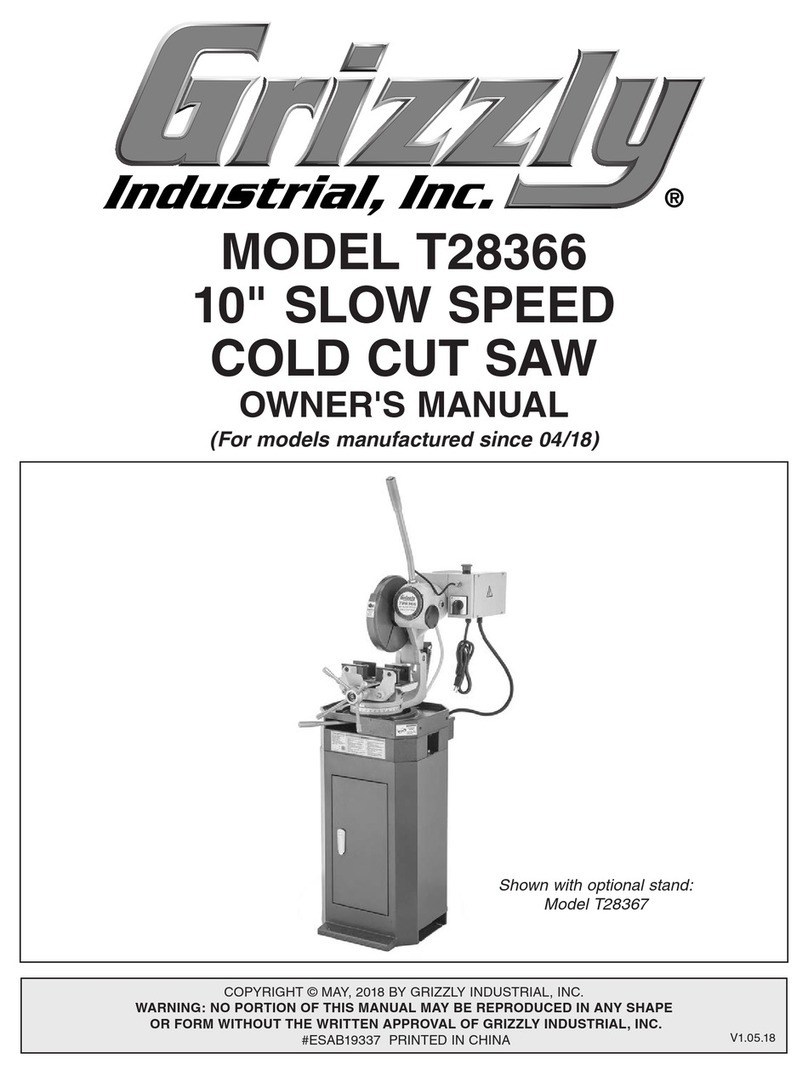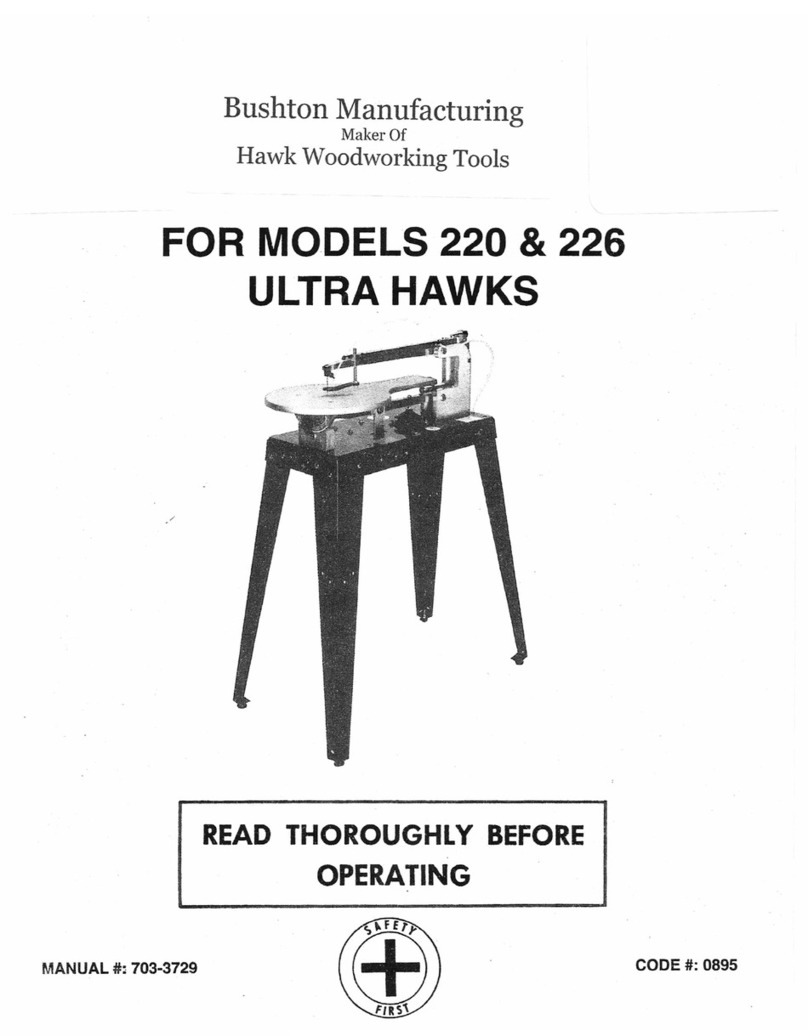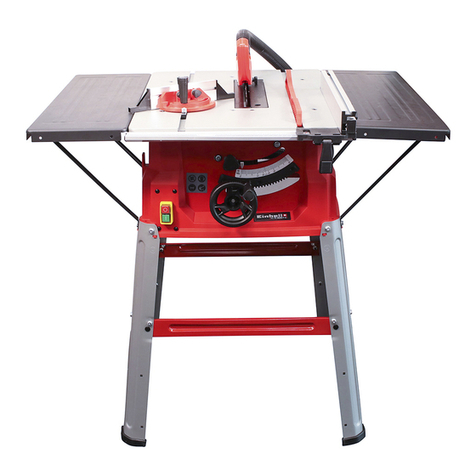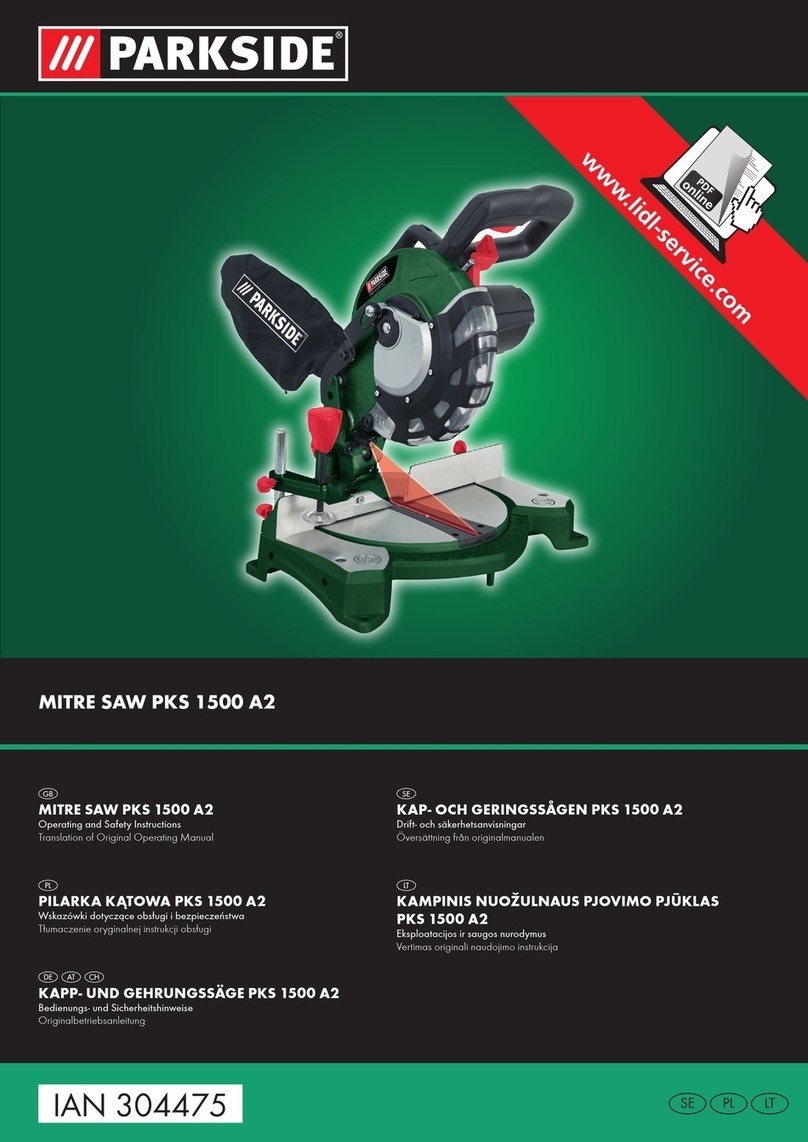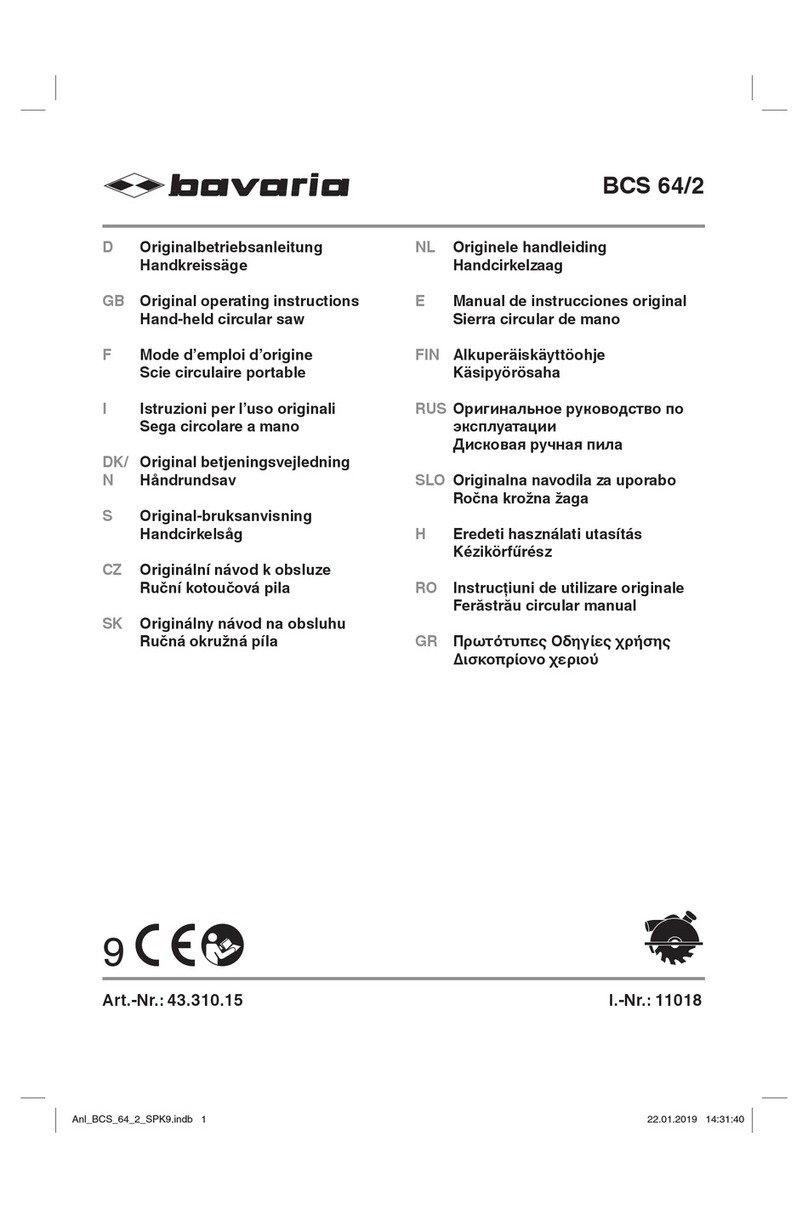Surtek SB714 Dimensions and installation guide

ATENCIÓN: Lea, entienda y siga las instrucciones de seguridad contenidas en este
manual antes de operar esta herramienta.
WARNING: Read, understand and follow the safety rules in this manual, before operating this tool.
Manual de Usuario y Garantía.
User’s Manual and Warranty. SB714
Sierra de Banda
Band Saw
SB714 manual.indd 1 28/05/15 10:48

2
ENGLISHESPAÑOL
General safety rules
Electric safety
Personal safety
Tool use and care
Specific safety rules for
band saw
Assembly & installation
Adjustments
Operation instructions
Maintenance
Troubleshooting
Technical data
Notes
Warranty policy
Normas generales de seguridad
Seguridad eléctrica
Seguridad personal
Utilización y cuidados de las
herramientas eléctricas
Advertencias de seguridad para
sierras de banda
Ensamble e instalación
Ajustes
Instrucciones de operación
Mantenimiento
Solucionador de problemas
Especificaciones técnicas
Notas
Garantía
9
9
9
10
10
10
11
12
12
13
13
14
16
3
3
3
4
5
5
6
7
7
7
8
14
16
CONTENIDO CONTENT
SÍMBOLOS SYMBOLS
PELIGRO, ADVERTENCIA, PRECAUCIÓN:
Indica un riesgo personal o la posibilidad
de un daño.
DANGER, CAUTION, WARNING: Indicates risk of
personal injury and/or the possibility of damage.
SB714 manual.indd 2 28/05/15 10:48

NORMAS GENERALES DE SEGURIDAD
Esta SIERRA DE BANDA tiene características
que harán su trabajo más rápido y fácil. Seguri-
dad, comodidad y confiabilidad fueron previs-
tos como prioridad para el diseño del mismo,
haciendo más fácil su operación.
ADVERTENCIA: Lea todas las advertencias
de seguridad y todas las instrucciones. La omi-
sión de alguna de las advertencias e instruccio-
nes que se enlistan a continuación puede dar
como resultado un choque eléctrico, fuego y/o
un daños serios.
CONSERVE TODAS LAS ADVERTENCIAS Y
TODAS LAS INSTRUCCIONES.
SEGURIDAD EN EL ÁREA DE TRABAJO
Mantenga el área de trabajo limpia y bien ilu-
minada. Las áreas desordenadas y oscuras pro-
vocan accidentes.
No maneje herramientas eléctricas en atmós-
feras explosivas, tales como en presencia de
líquidos inflamables, gases o polvo. Las herra-
mientas eléctricas crean chispas que pueden
encender el polvo o los humos.
Mantenga alejados a los niños y curiosos
mientras maneja una herramienta eléctrica.
Las distracciones pueden causarle la pérdida
del control.
SEGURIDAD ELÉCTRICA
La clavija de la herramienta eléctrica debe
coincidir con receptáculo. No modificar nunca
la clavija de ninguna manera. No usar ningún
adaptador de clavijas con herramientas eléctri-
cas puestas a tierra. Clavijas no modificadas y
bases coincidentes reducirán el riesgo de cho-
que eléctrico.
Evite el contacto del cuerpo con superficies
puestas a tierra como tuberías, radiadores, co-
cinas eléctricas y refrigeradores. Hay un riesgo
aumentado de choque eléctrico si su cuerpo
está puesto a tierra.
No exponga las herramientas eléctricas a la llu-
via o a condiciones de humedad. El agua que
entre en la herramienta aumentará el riesgo
de choque eléctrico.
No abuse del cable. No usar nunca el cable para
llevar, levantar o desenchufar la herramienta
eléctrica. Mantenga el cable lejos del calor,
aceite, cantos vivos o piezas en movimiento.
Los cables dañados o enredados aumentan el
riesgo de choque eléctrico.
Cuando maneje una herramienta eléctrica en
el exterior, use una prolongación de cable ade-
cuada para uso en el exterior. El uso de una
prolongación de cable adecuada para uso en el
exterior reduce el riesgo de choque eléctrico.
“ESTA HERRAMIENTA CUENTA CON UN
SUJETACABLE TIPO “Y“, EN CASO DE DAÑAR-
SE EL CORDÓN DE ALIMENTACIÓN, ÉSTE DE-
BERÁ SER REEMPLAZADO POR EL FABRICANTE,
SUS CENTROS DE SERVICIO AUTORIZADOS, O
PERSONAL CALIFICADO A FIN DE EVITAR RIES-
GOS.”
EXTENSIONES DE CABLE
NOTA: El uso de cables dañados incrementa el
riesgo de descargas eléctricas o quemaduras.
Si es necesario un cable de extensión, debe ser
usado un cable con el tamaño adecuado de los
conductores. La tabla de la siguiente página,
muestra el tamaño correcto para usar depen-
diendo en la longitud del cable y el rango de
amperaje especificado en la etiqueta de valo-
res nominales del producto. Si está en duda,
use el rango próximo más grande.
Siempre use cables de extensión listados en UL,
CSA ó NOM.
TAMAÑOS RECOMENDADOS DE EXTENSIONES
DE CABLE:
Cuando esté usando el producto afuera, use
una extensión para exteriores marcadas con lo
siguiente: “WA” o “W”. Estas extensiones están
pensadas para trabajar en exteriores y reducen
el riesgo de descarga eléctrica.
SEGURIDAD PERSONAL
Esté alerta, vigile lo que está haciendo y use el
sentido común cuando maneje una herramien-
ta eléctrica. No use una herramienta eléctrica
cuando esté cansado o bajo la influencia de
ESPAÑOL•Manual de Usuario
3
SB714 manual.indd 3 28/05/15 10:48

drogas, alcohol o medicamentos. Un momento
de distracción mientras maneja herramientas
eléctricas puede causar un daño personal serio.
Use equipo de seguridad. Lleve siempre pro-
tección para los ojos. La utilización para las
condiciones apropiadas de un equipo de segu-
ridad tal como mascarilla anti-polvo, zapatos
no resbaladizos, gorro duro, o protección para
los oídos reducirá los daños personales.
Evite un arranque accidental. Asegúrese de
que el interruptor está en posición apagado
antes de conectar a la red y/o a la batería, co-
ger o transportar la herramienta. Transportar
herramientas eléctricas con el dedo sobre el
interruptor o enchufar herramientas eléctricas
que tienen en interruptor en posición encendi-
do invita a accidentes.
Retire llaves o herramienta antes de arrancar
la herramienta eléctrica. Una llave o herra-
mienta dejada unida a una pieza rotativa de
una herramienta eléctrica puede causar un
daño personal.
No se sobrepase. Mantenga los pies bien asen-
tados sobre el suelo y conserve el equilibrio en
todo momento. Esto permite un mejor control
de la herramienta eléctrica en situaciones in-
esperadas.
Vista adecuadamente. No vista ropa suelta o
joyas. Mantenga su pelo, su ropa y guantes
alejados de las piezas en movimiento. La ropa
suelta, las joyas o el pelo largo pueden ser co-
gidos en las piezas en movimiento.
Si hay dispositivos para la conexión de medios
de extracción y recolección de polvo, asegúre-
se de que éstos estén conectados y se usen co-
rrectamente. El uso de estos dispositivos puede
reducir los peligros relacionados con el polvo.
IMPORTANTE: Este aparato no se destina
para utilizarse por personas (incluyendo niños)
cuyas capacidades físicas, sensoriales o menta-
les sean diferentes o estén reducidas, o carez-
can de experiencia o conocimiento, a menos
que dichas personas reciban una supervisión o
capacitación para el funcionamiento del apa-
rato por una persona responsable de su segu-
ridad. Los niños deben supervisarse para ase-
gurar que ellos no empleen los aparatos como
juguete.
UTILIZACIÓN Y CUIDADOS DE LAS
HERRAMIENTAS ELÉCTRICAS
No fuerce la herramienta eléctrica. Use la he-
rramienta eléctrica correcta para su aplicación.
La herramienta eléctrica correcta hará el tra-
bajo mejor y más seguro al ritmo para la que
fue concebida.
No use la herramienta eléctrica si el interrup-
tor no gira “encendido” y “apagado”. Cual-
quier herramienta eléctrica que no pueda con-
trolarse con el interruptor es peligrosa y debe
repararse.
Desenchufe la clavija de la fuente de alimen-
tación y/o de la batería antes de efectuar
cualquier ajuste, cambio de accesorios, o de
almacenar las herramientas eléctricas. Tales
medidas preventivas de seguridad reducen el
riesgo de arrancar la herramienta accidental-
mente.
Almacene las herramientas eléctricas inactivas
fuera del alcance de los niños y no permita el
manejo de la herramienta eléctrica a personas
no familiarizadas con las herramientas o con
estas instrucciones. Las herramientas eléctricas
son peligrosas en manos de usuarios no entre-
nados.
Mantenga las herramientas eléctricas. Com-
pruebe que las partes móviles no estén des-
alineadas o trabadas, que no haya piezas ro-
tas u otras condiciones que puedan afectar la
operación de las herramientas eléctricas. Las
herramientas eléctricas se reparan antes de su
uso, cuando están dañadas. Muchos acciden-
tes son causados por herramientas eléctricas
pobremente mantenidas.
Mantenga las herramientas de corte afiladas y
limpias. Las herramientas de corte mantenidas
correctamente con los bordes de corte afilados
son menos probables de trabarse y más fáciles
de controlar.
Use la herramienta eléctrica, accesorios y pun-
tas de herramienta, etc. de acuerdo con estas
instrucciones y de la manera prevista para el
tipo particular de herramienta eléctrica, te-
niendo en cuenta las condiciones de trabajo
y el trabajo a desarrollar. El uso de la herra-
mienta eléctrica para aplicaciones diferentes
de las previstas podría causar una situación de
peligro.
4
SB714 manual.indd 4 28/05/15 10:48

SERVICIO
Haga revisar su herramienta eléctrica por un
servicio de reparación calificado usando sola-
mente piezas de reemplazo idénticas. Esto ga-
rantizará que la seguridad de la herramienta
eléctrica se mantiene.
ADVERTENCIAS DE SEGURIDAD
PARA SIERRAS DE BANDA
1. Siempre permita que la hoja de la sierra se
detenga antes de quitar residuos y otros mate-
riales de la mesa.
2. Siempre mantenga las manos y los dedos ale-
jados de la sierra.
3. Nunca intente cortar piezas que no tengan
una superficie plana, a menos que utilice un
soporte adecuado.
4. Siempre sujete el material firmemente y ali-
méntelo hacia la hoja a una velocidad mode-
rada.
5. Siempre apague la máquina si quitara el ma-
terial haciéndolo un corte incompleto.
6. Ajuste la guía superior a 1/8” por encima del
material a cortar.
7. Tenga en cuenta el tamaño de la hoja, el es-
pesor y tipo de material a cortar.
8. Asegúrese de que la tensión de la hoja y su
avance estén bien ajustados.
9. Realice cortes de que deje libre un espacio
antes de cortar curvas amplias.
10. Libere la tensión la hoja cuando la sierra no
vaya a ser utilizada durante un largo periodo
de tiempo.
ENSAMBLE E INSTALACIÓN
IMPORTANTE: La sierra de banda se suminis-
tra parcialmente ensamblada. Antes de su uso,
siga las siguientes indicaciones de ensamble.
Desempaque la máquina y verifique que no
exista algún daño visible, que pudiera haberse
ocasionado durante el transporte. Si se detecta
algún daño, notifique a su proveedor inmedia-
tamente.
INSTALACIÓN DE LA MESA
Instale la mesa de trabajo (83) de acuerdo a la
figura 1. Ajuste la boca de la sierra (85) dentro
del centro de la mesa de trabajo. Una el blo-
que guía lateral (87) a la mesa, use cuatro tor-
nillos mariposa como se muestra en la Figura 1.
Luego inserte el perno de cuello cuadrado (76)
en la guía lateral de la mesa a través de una
arandela cuadrada (75). Ajuste la guía superior
de la mesa (79) y la guía lateral con la arandela
y la tuerca de mariposa. Ponga la guía superior
en el costado derecho de la hoja de la sierra.
Afloje las tuercas (77). Quite la guía superior
y afloje la tuerca de mariposa (76). Deslice el
soporte de la guía superior (74) al costado de-
recho de la hoja de la sierra (36). Luego ajuste
la guía superior sobre el otro lado del soporte
de la guía superior.
PRECAUCIÓN: Nunca fuerce el material a
pasar por la hoja de la sierra. Usted se familia-
rizara con las características de la sierra con la
práctica y el uso. Si es posible practique el corte
con un pedazo de madera.
AJUSTE DEL ÁNGULO DE LA MESA
1. Si se requiriera poner la mesa de trabajo a
cierto ángulo, asegúrese de instalar, el marco
rotativo de la mesa (Figura 2 - 95).
2. Afloje la tuerca de mariposa (73) y ajuste la
mesa de trabajo al ángulo deseado usando la
escala marcada en el transportador (88).
3. Apriete la tuerca de mariposa (73) asegurán-
dola de manera que la mesa no se mueva du-
rante la operación de trabajo.
LA HOJA DE LA SIERRA
PARA CAMBIAR LA HOJA DE LA SIERRA
ASEGÚRESE QUE EL INTERRUPTOR SE ENCUEN-
TRA EN LA POSICIÓN DE “APAGADO”. Y DES-
CONECTE LA MÁQUINA ANTES DE REALIZAR
CUALQUIERA DE LOS PASOS DESCRITOS A
CONTINUACIÓN.
1. Primero abra las puertas superior e inferior
(8 y 9), luego afloje el volante de mano (20).
Vea la figura 3.
5
ESPAÑOL•Manual de Usuario
Fig. 1
36
83
87 77 74 76
48
73
95
88
85
Fig. 2
SB714 manual.indd 5 28/05/15 10:48

6
2. Remueva el bloque guía lateral (87) y la hoja
(36). Vea la figura 1.
3. Seleccione e instale la hueva hoja.
4. Instale el bloque guía lateral (87).
5. Gire el volante de mano (20) para apretar la
hoja. Aplique a la hoja una presión de 3 Kg, la
deformación por tensión es alrededor de 8mm.
La tensión de la hoja debe ser moderada.
6. Tire de la hoja de la sierra a mano, ajuste
la trayectoria de la hoja (36) en la carcasa de
protección girando la perilla flor (33) en la
parte trasera de la carcasa de la polea superior
como se muestra en la figura 3 con el objetivo
de hacer que la hoja corra por el centro.
GUÍA DE LA HOJA
La guía de la hoja de la sierra de banda SB714
asegura la correcta trayectoria de la hoja para
cortes limpios. Cuando se utilicen navajas estre-
chas asegúrese que la guía inferior de la hoja
soporte la hoja por ambos lados y por atrás.
Ajuste los rodamientos (Figura 4 - 111) de la
guía superior de la hoja y del eje de la guía (66)
a aproximadamente 0.5 mm de la hoja, y el co-
jinete de empuje (109 y 62) de la parte trasera
de la hoja justo por encima de ella. No ajuste
los cojinetes demasiado cerca, ya que la fric-
ción genera calor, el cual puede tener un efec-
to perjudicial en los rodamientos así como en
la hoja.
AJUSTE DE LA ALTURA DE CORTE
La guía superior de la hoja debe ser siempre
instalada tan cerca como sea práctico de la
zona de trabajo. Para ajustarla, afloje la posi-
ción (Figura 4 - 1) de la tuerca de mariposa en
el costado de la carcasa de la polea superior, y
ajuste la guía de la hoja a la altura requerida.
Apriete la tuerca mariposa cuando termine de
ajustar.
INSTRUCCIONES DE OPERACIÓN
INFORMACIÓN DE SEGURIDAD
1. Verifique que las guardas estén posición y
aseguradas antes de encender la máquina.
2. Siempre desconecte la máquina de la fuente
de alimentación cuando se le preste servicio.
3. No utilice hojas de sierra dobladas o quebradas.
4. Reemplace la inserción de la mesa si la ranu-
ra ha sido ampliada.
5. Cuando corte piezas redondas utilice una
plantilla de sujeción adecuada para evitar que
el material de vuelta.
6. Cuando corte tablas en posición vertical use
un bloque de empuje adecuado para prevenir
un contragolpe.
7. Para mantener el riesgo a la salud en un ni-
vel mínimo, es recomendable siempre conectar
esta sierra de banda a un colector de polvo.
Los peligros mas comunes asociados con la
operación de las sierras de banda son los si-
guientes:
Riesgos asociados a la hoja de la sierra mientras
opera, ejemplo: contacto con los dientes de la
sierra. Cortes y partes de material arrojadas.
Contra golpe de la pieza de trabajo.
Las principales zonas de riesgo de la sierra de
banda son:
El área de trabajo. El área alrededor de la má-
quina en funcionamiento. El área de contra-
golpe.
A pesar del uso de los dispositivos de seguridad
específicos y del cumplimiento de todas las
regulaciones relevantes para la prevención de
accidente, cuando se opera una sierra d banda
los siguientes riesgos permanecen:
Daño auditivo por ruido excesivo. Riesgo de ac-
cidentes en las zonas de corte de la sierra que
no están protegidas. Riesgo de lesión cuando
se cambia la hoja de la sierra (Riesgo de corte
por el filo de los dientes). Riesgo por piezas o
material que pudiera salir arrojado.
Fig. 3 Fig. 4
20
33 62
66
109
111
SB714 manual.indd 6 28/05/15 10:48

7
ESPAÑOL•Manual de Usuario
Aplastamiento de los dedos. Riesgo de lesión
por el contragolpe de las piezas. Riesgo a la sa-
lud causado por la emisión de polvo, especial-
mente de madera de haya o roble.
MANTENIMIENTO
LIMPIEZA GENERAL
• Mantenga limpios las guías de rodamientos y
libres de acumulación de alquitrán, resina, etc.
• Limpie los depósitos de los rodamientos para
ayudar a evitar la vibración y la rotura prema-
tura de hoja.
• Mantenga el interior de la sierra de banda
limpia de aserrín. De vez en cuando limpie el
interior de la unidad o sople el interior de la
unidad con un compresor de aire.
• Limpie y engrase el mecanismo de ascenso
/ descenso.
SOLUCIONADOR DE PROBLEMAS
Esta sección cubre los problemas del proceso
de aserrado más comunes encontrados y dice
que hacer al respecto.
No haga ningún ajuste hasta que la sierra de
banda este desconectada y las partes móviles
hayan alcanzado el alto total.
EL MOTOR NO ARRANCA
1. La fuente de poder no está encendida. . Ve-
rifique todo el circuito eléctrico.
2. El fusible del circuito se ha quemado. Cam-
bie el fusible.
3. Cable dañado. Reemplace el cabe.
4. El interruptor no está en la posición de “en-
cendido. Verifique el interruptor.
5. El motor está dañado. El motor está dañado.
LA HOJA DE LA SIERRA NO CORTA O LA VE-
LOCIDAD DE CORTE ES DEMASIADO BAJA
1. La hoja de la sierra está instalada al revés,
los dientes de la sierra cortan en la misma di-
rección. Voltee la hoja de la sierra e instálela
nuevamente.
2. Hay algunos residuos duros tales como
piedra o acero en los dientes de la sierra. Re-
mueva los residuos y afile los dientes.
3. Los dientes de la sierra se han mellado o per-
dido el filo debido al tiempo de uso. Afile los
dientes de la sierra o cambie la hoja por una
nueva.
CORTES SINUOSOS
1. La hoja no está recta. Reinstale la hoja de la
sierra de manera correcta.
2. La polea superior no está paralela a la polea
inferior. Ajuste la polea superior para ponerla
en paralelo con la inferior.
3. La instalación de la guía de la hoja esta incli-
nada. Ajuste la guía de la hoja para hacer que
la dirección de su trayectoria sea la misma que
la de la hoja.
LA HOJA DE LA SIERRA ESTÁ ROTA
1. La guía esta inclinada. Ajuste la guía .
2. La inclinación de los dientes de la sierra es
demasiado pequeña o los dientes de la sierra
no tienen filo. Remodele la ruta de la sierra,
afile los dientes de la sierra.
3. Cuando se corta madera de diámetro pe-
queño, la sierra de la hoja se tuerce de mala
forma. Instale la hoja estrecha para ensanchar
la ruta de la sierra.
4. La velocidad con la que la madera se pasa
por la sierra es muy alta. Reduzca la velocidad
con la que se pasan los materiales
5. La hoja de la sierra esta demasiado tensa.
Afloje la hoja de la sierra apropiadamente.
6. La hoja de la sierra esta sobre el periodo
de termino de garantía. Renueve la hoja de
la sierra.
ESPECIFICACIONES TÉCNICAS
Potencia
Voltaje-Frecuencia
Capacidad de corte
Inclinación de la mesa
Largo y grosor de la cinta
de sierra
Espesor de la sierra cinta
Peso
750 W (1 HP)
120 V ~ 60 Hz
33,5 cm x 16 cm
0-45˚ (derecha - izquierda)
248 cm x 1,3 cm
0,52 mm
85 kg (187 lb)
SB714 manual.indd 7 28/05/15 10:48

8
GENERAL SAFETY RULES
Your BAND SAW has many features that will
make your job faster and easier. Safety, perfor-
mance and reliability have been given top prior-
ity in the design of this tool, qualities to make
easy to maintain and to operate.
WARNING: Read and understand all instruc-
tions. Failure to follow all indications listed be-
low, may result in electric shock, fire and/or seri-
ous personal injury.
SAVE THESE INSTRUCTIONS.
SAFETY IN WORKING AREA
Keep your work area clean and well lit. Clut-
tered benches and dark areas may cause acci-
dents.
Do not operate power tools in explosive atmo-
spheres, such as in the presence of flammable
liquids, gases or dust. Some power tools create
sparks which may provoke fire.
Keep away observers, children and visitors
while operating a power tool. Distractions can
cause you to lose control.
ELECTRIC SAFETY
Double insulation eliminates the need for the
three wire grounded power cord and grounded
power supply system.
Avoid the body contact with grounded surfaces
such as pipes, radiators and refrigerators. There
is an increased risk of electric shock if your body
is grounded.
Don’t expose power tools to rain or wet con-
ditions. The presence of water into power tools
will increase the risk of electric shock.
Do not abuse of the power cord. Never use the
power cord to carry the tool and do not pull
the plug off the outlet. Keep the cable away of
heat, oil, sharp edges or moving parts. Replace
damaged cords immediately. Damaged cords in-
crease the risk of electric shock.
When operating a power tool outside, use an
outdoor extension cord marked “W-A” or “W”.
These cords are rated for outdoor use and re-
duce the risk of electric shock.
EXTENSION CORDS
Replace damaged cords immediately. The use
of damaged cords can shock, burn or electric
shock. If an extension cord is necessary, a cord
with adequate size conductors should be used to
prevent excessive voltage drop, loss of power or
overheating. The table below shows the correct
size to use, depending on cord length and name-
plate amperage rating of tools. In case of doubt
use the next heavier gauge. Always use UL listed
extension cords.
SIZE RECOMMEND EXTENSION CABLES
PERSONAL SAFETY
Stay alert, watch what you are doing and use
common sense when operating a power tool.
Don't use the tool if you are tired or under the
influence of drugs, alcohol or medication. A
moment of inattention while operating power
tools may cause a serious personal injury.
Dress properly. Do not wear loose clothing or
jewelry. Contain long hair. Keep your hair, cloth-
ing and gloves away of moving parts. Loose
clothes, jewelry or long hair can be caught in
moving parts.
Avoid an accidental starting. Be sure that the
switch is OFF before plugging in. Carrying tools
with the finger on the switch or plug in the tool
switch in ON may cause accidents.
Remove the adjusting keys or wrenches before
turning the tool on. A wrench or a key that is left
close to a rotating part of the tool may provoke
a personal injury.
Do not overreach. Keep proper footing and bal-
ance at all times. Proper footing and balance en-
ables better control of the tools on unexpected
situations.
Use safety equipment. Always wear eye protec-
tion. Dust mask, nonskid safety shoes, hard hat,
or hearing protection must be used for appropri-
ate conditions.
Before connecting the tool to a power source
(receptacle, outlet, etc.) be sure that the voltage
supplied is the same as that one specified on
the nameplate of the tool. To use a not specified
voltage may cause a serious injury to the user as
well as damage the tool.
SB714 manual.indd 8 28/05/15 10:48

ENGLISH•User's manual
9
IMPORTANT: This appliance is not intended
for use by persons (including children) with re-
duced physical, sensory or mental capabilities
may be different or reduced, or lack of experi-
ence or knowledge, unless such persons are su-
pervised or trained to operate the product by
a person responsible for their safety. Children
should be supervised to ensure they do not use
the devices as toys.
TOOL USE AND CARE
Do not force the power tool. Use the correct tool
for the application. The correct tool will do the
job better and more safely at the rate that it was
designed to work at.
Do not use tools if switch does not turn it on or
off. Any tool that cannot be controlled with the
switch is dangerous and must be repaired.
Disconnect the plug from the power source be-
fore making any adjustments, changing acces-
sories or storing the tool. This preventive safety
measures reduce the risk of accidental starting
of the tool.
When the power tool is not in use, store it out
of the reach of children, and do not allow in-
dividuals who are not familiar with the power
tool or these instructions to operate it. Power
tools are dangerous in the hands on untrained
users.
Maintain the power tool. Check for misalign-
ment or binding of moving parts, broken parts,
and any other condition that may affect the op-
eration of the power tool. If it is damaged, have
it repaired before using. Many accidents are
caused by poorly maintained power tools.
Check for misalignment or bonding of moving
parts, breakage parts, and any other condition
that may affect the tools operation. If you find
a damaged tool, take it to service before use it.
Use only accessories that are recommended by
the manufacturer of your model. Suitable ac-
cessories for one tool, may become hazardous
when are used on another tool.
Keep cutting tools, sharpened and clean. Cut-
ting tools in good condition with sharpened
edges, are less likely to stuck in workpieces or
easier to control.
Is recommendable to use a safety device suit-
able, such a thermal and differential switch
when you are using an electric equipment.
SERVICE
Tool service must be performed only by qualified
repair personnel. Service or maintenance per-
formed by unqualified personnel could result in
a risk of injury.
SPECIFIC SAFETY RULES FOR
BAND SAWS
1. Always allow the band saw blade to stop be-
fore removing scrap pieces from table.
2. Always keep hands and fingers away from the
blade.
3. Never attempt to saw stock that does not have
a flat surface, unless a suitable support is used.
4. Always hold material firmly and feed it into
the blade at a moderate speed.
5. Always turn off the machine if the material is
to be backed out of an uncompleted out.
6. Adjust the upper guide about “1/8” above the
material being cut.
7. Check for proper blade size and type for thick-
ness and type of material being cut.
8. Make sure that the blade tension and blade
tracking are properly adjusted.
9. Make “relief” cuts before cutting long curves.
10. Release blade tension when the saw will not
be used for a long period of time.
ASSEMBLY & INSTALLATION
IMPORTANT: This machine is shipped partly
disassembled saw table and star knob have to be
installed prior to use.
Unpack machine and check for any visible dam-
age which may have occurred during transport.
If a damage is detected notify your dealer im-
mediately.
INSTALLING TABLE
Install worktable (83) according to figure 1. Fix
the saw mouth (85) into the center of worktable.
Connect the guide board (87) with the table use
four butterfly screw bolts as figure 1. Then make
the square neck bolt (76) plug in the side guide
board through strip-shaper washer (75). Fix the
upper guide board (79) and side guide board
with washer and butterfly nut.
Put the upper board on the right side of saw
blade. Loosen the nuts (77). Take off the upper
guide board and loosen the butterfly nut (76).
Slip the stand of upper guide board (74) to the
SB714 manual.indd 9 28/05/15 10:48

10
right side of saw blade (36). Then fix the upper
guide board on the other side of the stand of
upper guide board.
CAUTION: Never force the material into the
band saw. You will become familiar with the
saw's features from practice and use. If possible,
practice sawing with a piece of wood.
ADJUSTING TABLE ANGLE
1. If working table is to be used at an angle,
make sure to install the angle core board.
2. Loosen butterfly nut (32) and adjust working
table to the desired angle using the numbers on
the rotating angle rule (88).
3. Tighten butterfly nut (73) securely so that the
working table will not move during operation.
MANUAL TO SAWBLADE
TO CHANGE SAW BLADE: MAKE SURE SWITCH
IN “OFF” POSITION. AND UNPLUG THE SANDER
BEFORE PERFORMING ANY OF THE STEPS BELOW.
1. First open the upper door and lower door (8 &
9), then loosen hand wheel (20). See Fig. 3.
2. Remove side guide board (87) and saw blade
(36). See figure 1.
3. Select and install the new one.
4. Install the side guide board (87).
5. Roll the hand wheel (20) to tighten the saw
blade. Give the saw blade 3 kg side pressure ten-
sile deformation is about 8 mm. The tension of
saw blade is moderate.
6. Roll the upper saw blade with hand, adjust
the running track of saw blade(36) in the protec-
tive case by rolling the flower handle (33) of the
back of upper saw wheel housing as shown in
figure 3, in order to make the saw blade run in
the center.
BLADE GUIDING
The saw blades guide of this band saw model
SB714 ensure an exact guiding of the blade for
clean cuts. When using narrow blades ensure
that the lower blade guide positively supports
the blade from both sides and the rear.
Set the bearings (Fig.4 - 111) of the upper blade
guide and the guide axles (66) to within approxi-
mately 0.5mm of the blade, and the large thrust
bearing (109, 62) against the back of the blade
just clear of it. Do not set the bearing too close,
as the friction generates heat, which may have
an adverse effect on the bearings and the saw
blade as well.
SETTING THE CUTTING HEIGHT
The upper blade guide should always be set as
close as practical against the wok. To adjust,
loosen the position (figure 4 - 1) of the wing nut
at the side of the upper wheel housing, and set
the blade guide to the required height.
Tighten wing nut after setting.
OPERATION INSTRUCTIONS
SAFETY INFORMATION
1. Check that guards are in place and securely
locked before switching the machine on.
2. Always disconnect from power when servicing
this machine.
3. Do not use bent or cracked band saw blades.
4. Replace table insert if slot has enlarged.
5. When cutting round stock use a suitable jig of
fixture to keep the work from turning.
6. When cutting boards in an upright position
use a suitable push block to prevent kickback.
7. To keep health risk to a minimum it is recom-
mend to always connect this band saw to a dust
collector.
Fig. 3 Fig. 4
20
33 62
66
109
111
Fig. 1
36
83
87 77 74 76
48
73
95
88
85
Fig. 2
SB714 manual.indd 10 28/05/15 10:48

11
ENGLISH•User's manual
The most common hazards associated with the
operation of band saws ate the following:
A hazard by the running saw blade, e.g. contact
with the teeth of the blade. Flinging of cutoffs
or knots. Work-piece kickback.
The principal hazard areas of a band saw are:
The work area. The area around a running ma-
chine. The kickback area.
Despite the use of the specific safety devices and
compliance with all relevant regulations for the
prevention of accidents, when operating a band
saw the following residual risks remain:
Hearing damage by excessive noise. Danger of
accidents in the unprotected cutting area of the
running saw blade. Danger of injury when chang-
ing blades ( danger of cuts by the sharp teeth ).
Endangering by flung about workpieces or parts.
Squashing of fingers. Danger of injury by kickback
of workpieces. Health risk caused by the dust emis-
sion, especially from oak and beech saw dust.
MAINTENANCE
GENERAL CLEANUP
• Keep the bearing guides clean and free of
buildup of pitch, resin, etc.
• Remove any deposits from the wheels to help
avoid vibration and premature blade breakage
• Keep the inside of bandsaw clear of sawdust.
Occasionally vacuum out the inside of the unit or
blow out the inside of the unit with an air hose.
• Clean and grease the raising /lowering mecha-
nism if the unit becomes difficult to move.
TROUBLESHOOTING
THE MOTOR CAN NOT START
1. The power isn't on. Check the electric circuit.
2. The fuse of electric circuit has blown. Change
the fuse.
3. The cord cable is damaged. Replace cord.
4. The switch isn’t “on”. Check the switch.
5. The motor is damaged. Change the motor.
THE SAW BLADE CAN NOT CUT OR THE CUT-
TING SPEED IS SLOW.
1. The saw blade is installed on the contrary, the
saw teeth cut on the same direction. Turn over
the saw blade and install it again.
2. There are some hard things such as iron or
stone etc in the saw teeth. Manage to remove
the hard things, resharpen the saw teeth.
3. The saw teeth is passive for long time using.
Repair and grind the saw teeth to make it sharp.
SLIPPING SAW BLADE
1. The saw blade is not straight. Reinstall the up-
to –standard saw blade.
2. The upper wheel doesn’t parallel with the
lower one. Adjust the upper wheel to make it
parallel with the lower one.
3. The guiding installation of the saw blade
has deflected. Adjust the guiding installation to
make its running direction as same as the saw
blade's.
THE SAW BLADE IS BROKEN
1. The direction of the guiding board is de-
flected. Adjust the guiding board correctly.
2. The deflection of the saw teeth is too small
or the saw tooth is passive. Reinstall the narrow
saw blade to make the saw route wide.
3. When cutting too small diameter wood, the
saw blade is sprained badly. Reinstall the nar-
row saw blade to make the saw route wide.
4. Speed of filling wood is too high. Slow the
speed of sending materials.
5. The saw blade is too tightened. Loosen the
saw blade properly.
6. The saw blade is over warrantable period. Re-
new the saw blade.
TECHNICAL DATA
Power
Voltage-Frequency
Cutting capacity
Table tilting
Length & width of blade
Blade thickness
Weight
750 W (1 HP)
120 V ~ 60 Hz
33,5 cm x 16 cm
0-45˚ (right - left)
248 cm x 1,3 cm
0,52 mm
85 kg (187 lb)
SB714 manual.indd 11 28/05/15 10:48

12
SB714
ESPAÑOL
PÓLIZA DE GARANTÍA
ENGLISH
WARRANT POLICY
Urrea Herramientas Profesionales S.A. de C.V.
Warranties this product for a period of 1 year in
its parts, components and manual labour against
any manufacture defect from the purchasing date.
Purchase date: ____/____/____
Product:____________________
Brand:______________________
Model:______________________
______________________________
Distributor seal and signature
Sold and Imported by:
Urrea Herramientas Profesionales S.A. de C.V.
km 11,5 Carretera A El Castillo, El Salto, Jalis-
co, México. C. P. 45680, Tel. (33) 3208 7900,
RFC UHP900402Q29
Terms:
In order to make warranty effective you must pres-
ent the product along with the warranty properly
fillled and signed to an authorized distributor or
service center.
Urrea Herramientas Profesionales S.A. de C.V.
will cover the transportation cost related to the
warranty.
This warranty is not applicable in the follow-
ing cases:
· When the product has not been used according
to normal conditions or natural wear of its parts.
· When the product has not been used according
with this user’s manual instructions.
· When the product has been fixed or modified by
unauthorized or unqualified person.
Urrea Herramientas Profesionales S.A. de C.V.
garantiza este producto por el termino de 1 año
en sus piezas, componentes y mano de obra con-
tra cualquier defecto de fabricación a partir de la
fecha de entrega.
Fecha de venta: ____/____/____
Producto: ___________________
Marca: ______________________
Modelo: ____________________
______________________________
Sello y firma de distribuidor
Comercializado e Importado por:
Urrea Herramientas Profesionales S.A. de C.V.
km 11,5 Carretera A El Castillo, El Salto, Ja-
lisco, México. C. P. 45680, Tel. (33) 3208 7900,
RFC UHP900402Q29
Condiciones:
Para hacer efectiva la garantía deberá presentar
el producto junto con la póliza de garantía debi-
damente firmada y sellada por el establecimiento
donde la adquirió, en cualquiera de los centros de
servicio autorizados.
Los gastos de transportación que se deriven del
cumplimiento de la garantía serán cubiertos por:
Urrea Herramientas Profesionales S.A. de C.V.
Esta garantía no será valida en los siguientes
casos:
· Cuando el producto haya sido utilizado en condi-
ciones distintas a las normales o al desgaste natu-
ral de sus partes.
· Cuando el producto no haya sido operado de
acuerdo al instructivo de uso que lo acompaña.
· Cuando el producto haya sido alterado o repara-
do por personas no autorizadas.
SB714 manual.indd 12 28/05/15 10:48
Table of contents
Languages:
Other Surtek Saw manuals
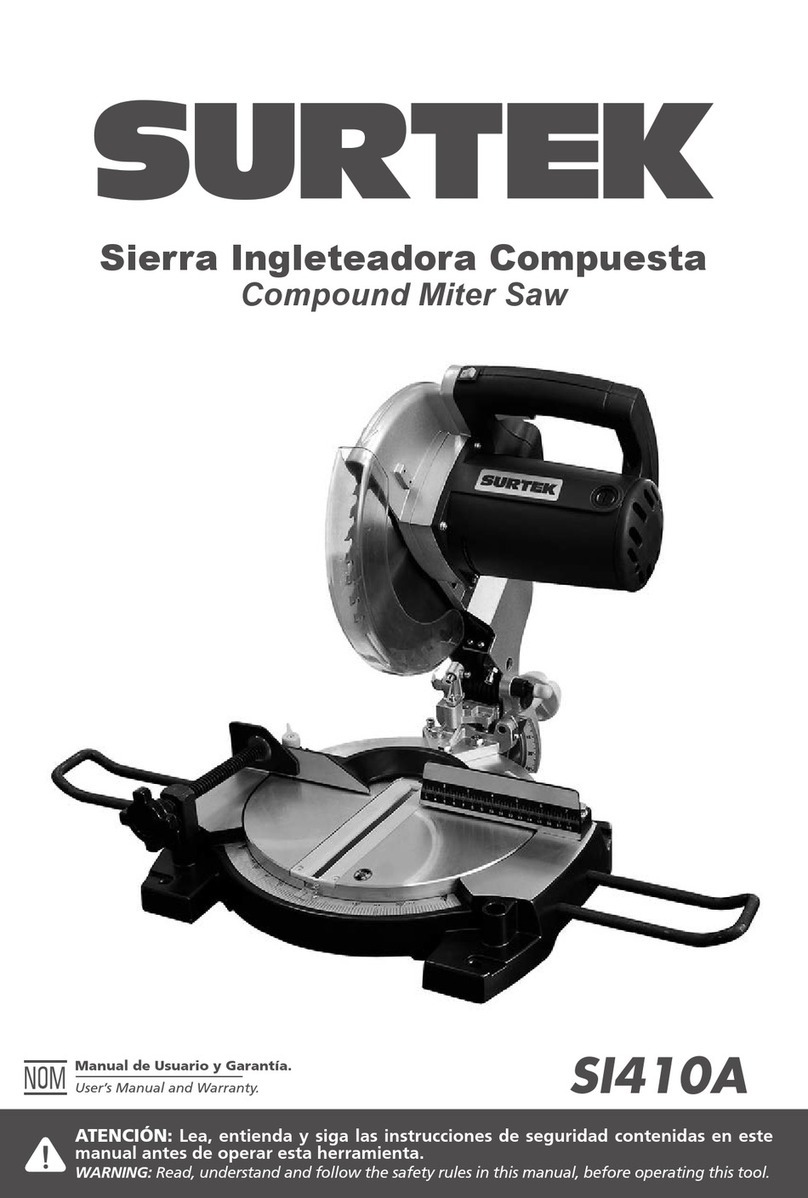
Surtek
Surtek SI410A User manual
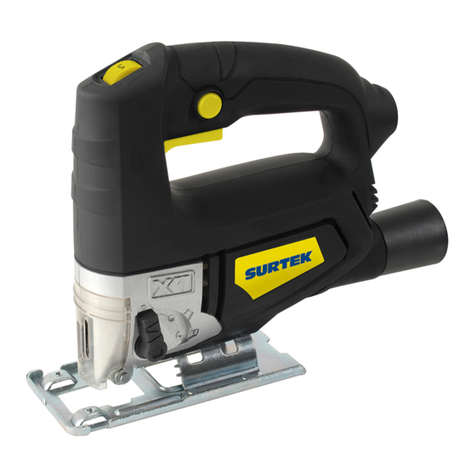
Surtek
Surtek SK403C Dimensions and installation guide
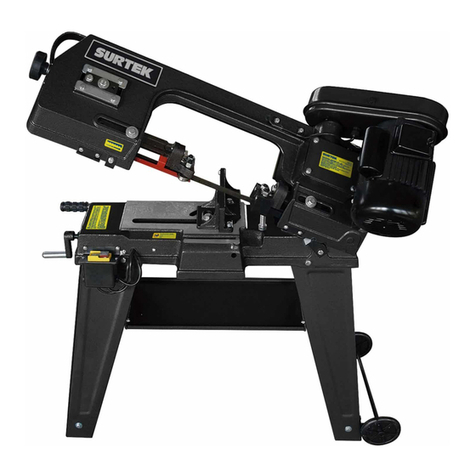
Surtek
Surtek CM512 Dimensions and installation guide
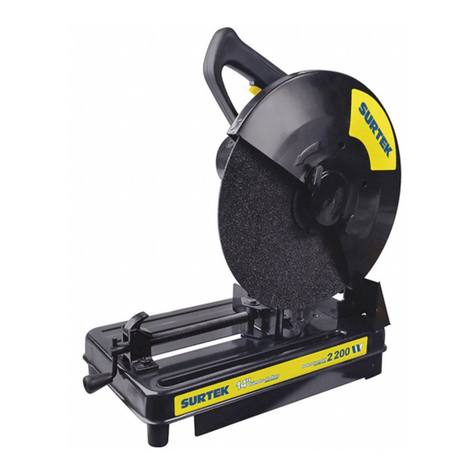
Surtek
Surtek CM714A User manual
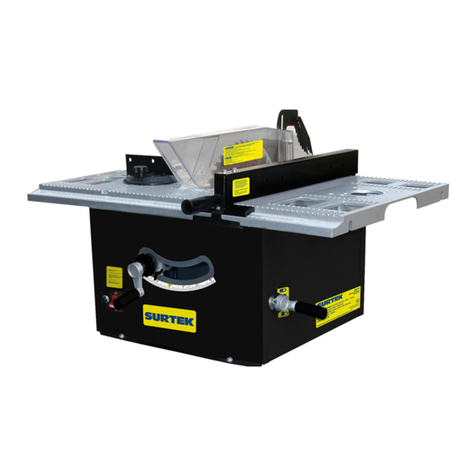
Surtek
Surtek SM710 Dimensions and installation guide
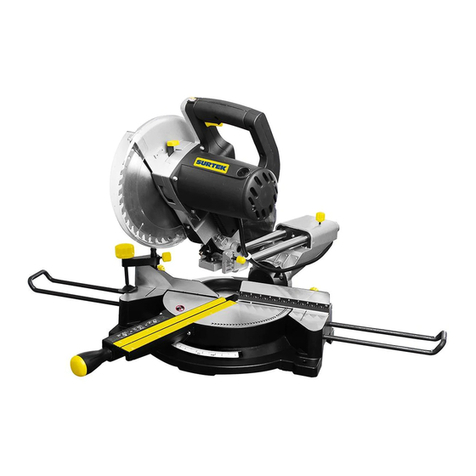
Surtek
Surtek SI710A Dimensions and installation guide
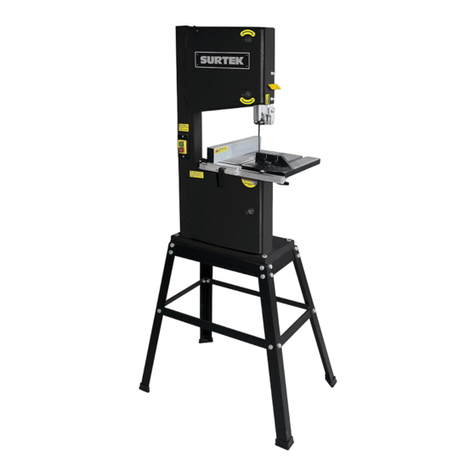
Surtek
Surtek SB710 Dimensions and installation guide
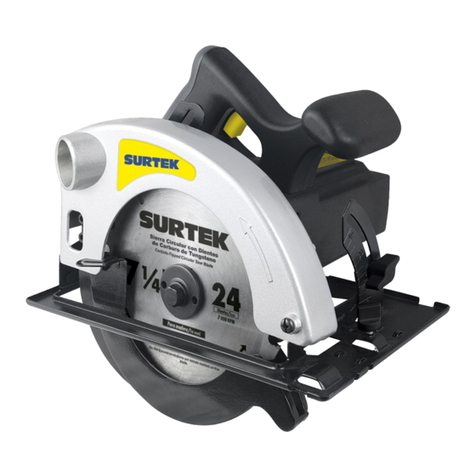
Surtek
Surtek SC407C Dimensions and installation guide
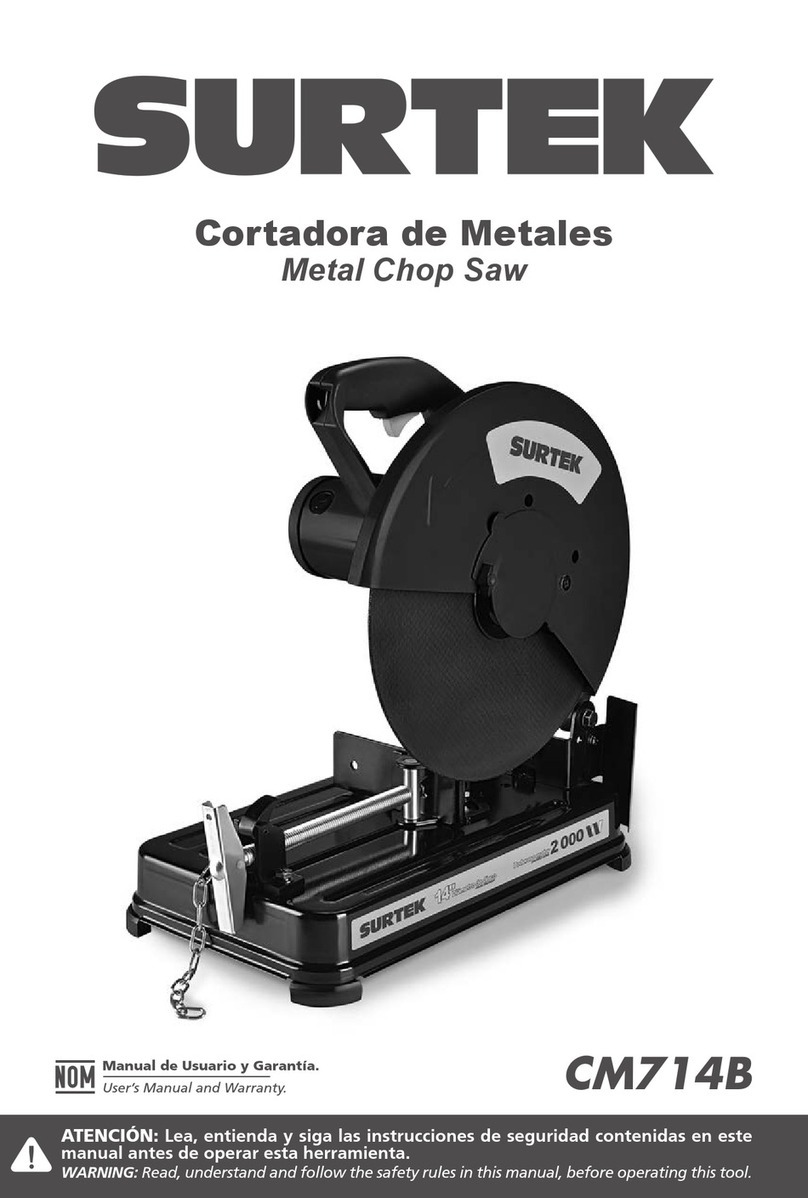
Surtek
Surtek CM714B Dimensions and installation guide
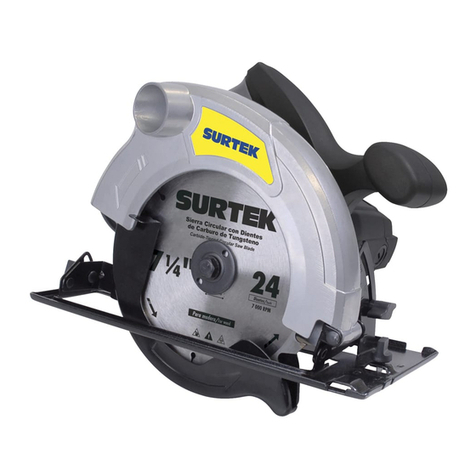
Surtek
Surtek SC707A User manual
